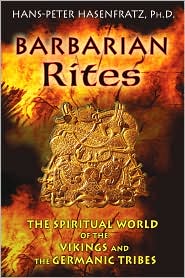
This is the first English translation of a scholarly survey of the cultural and spiritual practices of the ancient Scandinavians and Germanic tribes from approximately the 1st century BCE to the 12th century CE. Readers should be forewarned that this book contains some disturbingly explicit descriptions of brutality, so have a barf bag or your bottle of Rescue Remedy on hand through the first few chapters.
Barbarian Rites should be of great interest to Heathens for its content and treatment. Unlike most books on ancient Northern spirituality, Hasenfratz uses a wider range of multidisciplinary source texts, and most importantly, he doesn’t romanticize or glorify the subject at hand.
The author opens the book with quotes from the riveting account of Ibn Fadlan’s journey to the Volga in 921 CE. As secretary to the Persian ambassador, Ibn Fadlan witnessed the lifestyles and customs of the Rūs (Rūsiya), a group of Germanic Varangians (Vikings). His descriptions reveal his mixture of admiration and disgust. “[The Rūs] are the filthiest of God’s creatures. They have no modesty in defecation or urination, nor do they wash after pollution from orgasm, nor do they wash their hands after eating.” It gets worse.
The author proceeds to cull information from a wide variety of primary resources, both native and Roman, to describe the society of the northern European tribes. The picture that emerges from these sources shows that these people were violent, brutal and barbaric communities of armed terrorists who looted and plundered to sustain their lifestyles. These practices were a necessity as the greater portion of a man’s wealth was destroyed at this death (a ship-burning funeral procedure for a king is described in nauseating detail by Ibn Fadlan). Thus very little wealth was inherited, and each man was compelled to accumulate his own wealth through predatory plundering. This was also their means of obtaining slaves to use and sell. Treatment of slaves was appalling and the author draws a connection between this extremely male-dominated robber baron culture and Hitler’s revival of the worst aspects of these ancient Germanic cultural practices of invasion, plundering and enslavement on a massive scale. Human and animal sacrifices were widespread as were brother-sister incest, the exposure of unwanted infants and the murder of the elderly who were no longer useful.
Following this vale of cultural horrors, the subsequent chapters provide the content advertised in the title. The chapter on rites of passage covers birth and death rites. There are descriptions of the male-only initiations into the Männerbund, the tribal warrior groups that taught the shamanic secrets of attaining berserker rages. Further chapters explore magical practices, the pantheons of deities, supernatural beings and revenants (spirits of the dead) and related superstitions and necromancy practices, and ideas of reincarnation. Chapter 6 gives a brief overview of cosmography (a map of the worlds of men, deities and supernatural beings). The final chapter describes the beginning and end of the world in Northern myth and notes the close ties to the apocalyptic Biblical, Persian and Indian myths. A common Indo-European source is suggested as a reason for the similarities. Other books offer better details on the topics of these last two chapters. Translator notes are formatted as footnotes; end matter includes the author’s endnotes, a detailed bibliography, and an index.
The translator, Michael Moynihan, explains that there are more in-depth books about early northern Europeans that haven’t been translated into English yet. For that reason, this book is an important contribution to literature on this subject. It presents a historically accurate survey of this culture that may serve to mitigate the glamorized “master race,” as many will find it exceedingly difficult to admire a culture that lionized lazy bullies, brutalized women, children and the elderly, and preyed upon and terrorized distant tribes as an ongoing form of employment. The harsh elegance of Northern mythology is sharply counterbalanced by the reality of the culture that created it.
This is a must-read for Heathens and an essential text for scholars of ancient civilizations. A hearty “Well Done!” to the author and translator for an unflinchingly honest look at this culture, and to Inner Traditions for publishing this singular text.
~review by Elizabeth Hazel
Author: Hans-Peter Hasenfratz, PhD, translated by Michael Moynihan
Inner Traditions, 2011
Verlag Herder GmbH, 1992 with the original title “Die religiöse Welt der Germanen: Ritual, Magie, Kult, Mythus”)
pp. 164, $16.95
